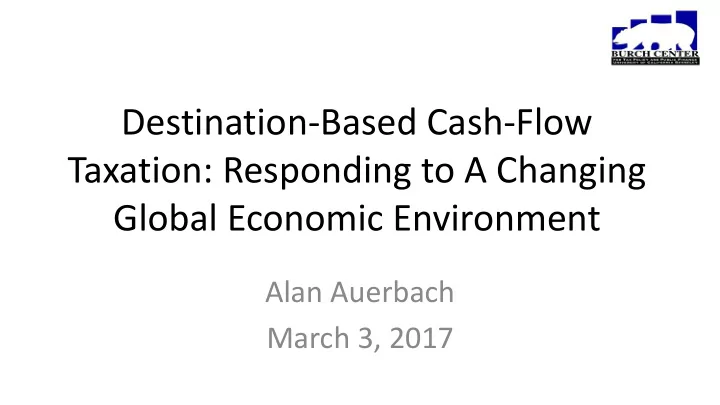

Destination-Based Cash-Flow Taxation: Responding to A Changing Global Economic Environment Alan Auerbach March 3, 2017
Top Five US Companies 1964: 2014: 1. AT&T 1. APPLE 2. GENERAL MOTORS 2. EXXON MOBIL 3. EXXON MOBIL 3. BERKSHIRE HATHAWAY 4. IBM 4. ALPHABET 5. TEXACO 5. MICROSOFT
A Changing Economic Setting In half century ending in 2014 in US: • Share of IP in nonresidential assets doubled (BEA, Fed) • Share of before-tax corporate profits of US resident companies coming from overseas operations quadrupled (BEA)
Summary • A rise in multinational activity • Increasing importance of intellectual property in value creation • A weaker link between production and sales locations, and less ability to identify the location of production and value creation • Implication: Pressure on systems that tax corporate income using residence or source
Outline • Major elements of the DBCFT • Its economic effects – Investment and finance – Profit-shifting and inversions – Exchange rates – Trade – Asset values – Location of production
Major Elements • Cash flow tax – Replace depreciation deductions with expensing – Eliminate interest deductions • Destination basis – Drop foreign-source income from base, as under a territorial system – Border adjustments effectively take export receipts and import costs out of business tax base
Relation to a VAT • Like a VAT, but with a deduction for labor costs • Equivalent system: – A VAT (subtraction method) – A payroll tax credit at the corporate tax rate • Result: a progressive consumption tax
House Blueprint • 20% tax rate (25% for pass-throughs) – In principle, border adjustment should be at same rate for both • One-time tax on accumulated offshore earnings – 8.75 percent on cash/cash equivalents; otherwise 3.5 percent (payable over an eight-year period) • Tax on net interest income • Financial services – TBD; various alternatives*
Investment and Finance • Expensing – A bigger incentive for domestic investment • Loss of interest deduction – Reduces incentive to use debt rather than equity finance and weakens increased incentive for investment • Interest rates – Downward pressure from weaker borrowing demand
Profit-Shifting and Inversions • Related-party cross-border transactions have no impact on US tax base – But shifting profits out of US means higher profits elsewhere, so reverse direction of profit-shifting • Loss of interest deduction encourages borrowing elsewhere • Elimination of tax on foreign source income means no reason to avoid US residence – But residence-based features elsewhere may encourage inversion into US
Exchange Rates and Trade • Border adjustments would appear to make US imports more expensive and world prices of US exports cheaper – But border adjustment should lead to dollar appreciation that offsets potential rise in US import prices or fall in world prices of US exports
Exchange Rates and Trade • US importer: – Before (at 20% tax rate): dollar-euro parity, so 100 euro import costs 100 dollars before tax and 80 dollars after tax – After: euro = .8 dollars, so 100 euro import costs 80 dollars before and after tax • Effective tax rate rises; no change in bottom line
Exchange Rates and Trade • US exporter: – Before (at 20% tax rate): dollar-euro parity, so 100 euro export delivers 100 dollars before tax and 80 dollars after tax – After: euro = .8 dollars, so 100 euro export delivers 80 dollars before and after tax • Effective tax rate falls; no change in bottom line
Exchange Rates and Trade • Symmetric border adjustment: a neutral impact on trade – A different result if only import tariff were imposed – some dollar appreciation, but still an increase in import prices and a decline in imports – Providing border adjustment only for revenues less labor costs would also look more like a tariff
Exchange Rate Adjustment • The dollar should adjust – Many complications, although not necessarily significant or pointing toward a lower adjustment* – Timing: response should anticipate implementation • If adjustment is incomplete… – An alternative mechanism through higher domestic wages and prices, but more gradual
Asset Values • With dollar appreciation comes decline in dollar value of foreign-currency denominated assets (and liabilities) of US firms, individuals – Estimate: as high as about $2 trillion, but possibly much lower*
Location of Production • Lower relative value of foreign operations also has implications for location of new operations – 20 percent relative decline in value of overseas operations – as if US tax were imposed on US and domestic profits, so no additional tax on US operations – This logic holds for US companies and foreign companies
Summary • A simple, durable and progressive tax system – No distortion of trade – Neutral treatment of debt and equity – Elimination of incentives for profit shifting and inversion – Elimination of tax on US-source profits
Recommend
More recommend